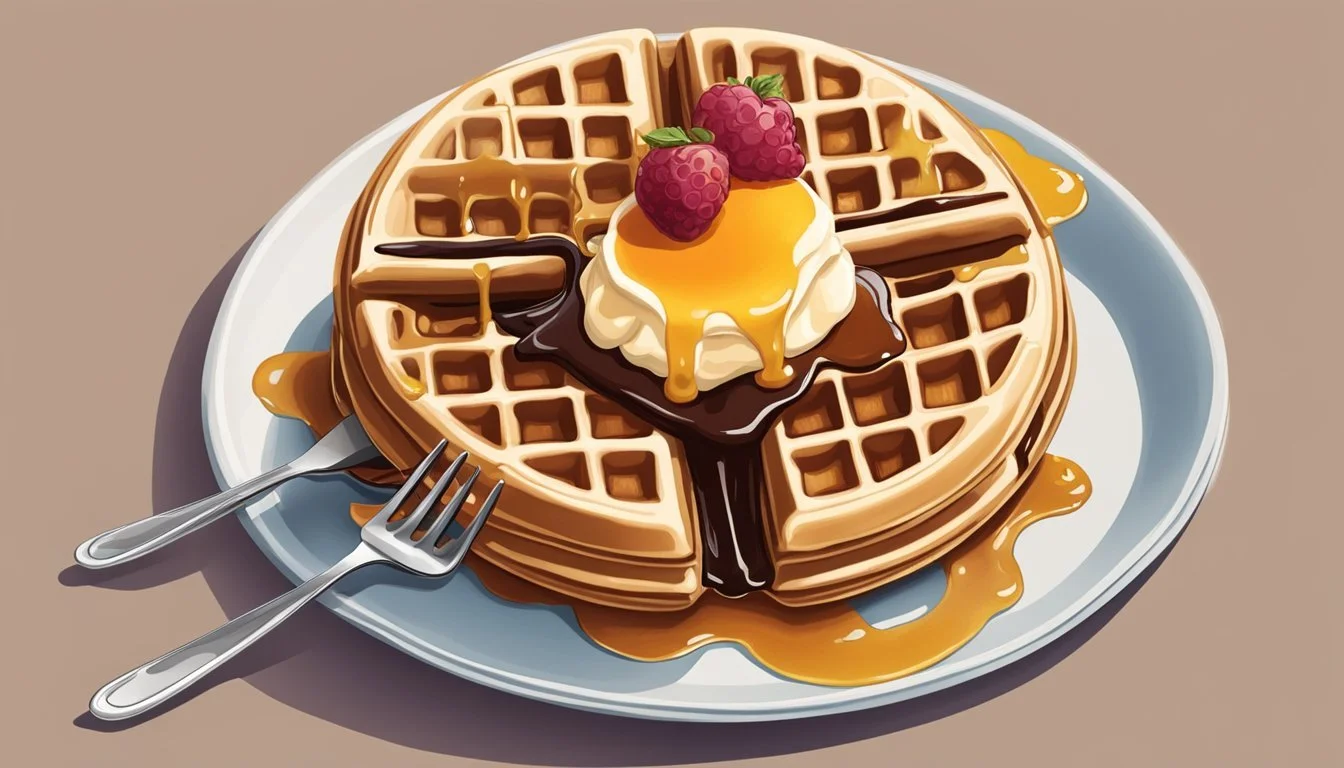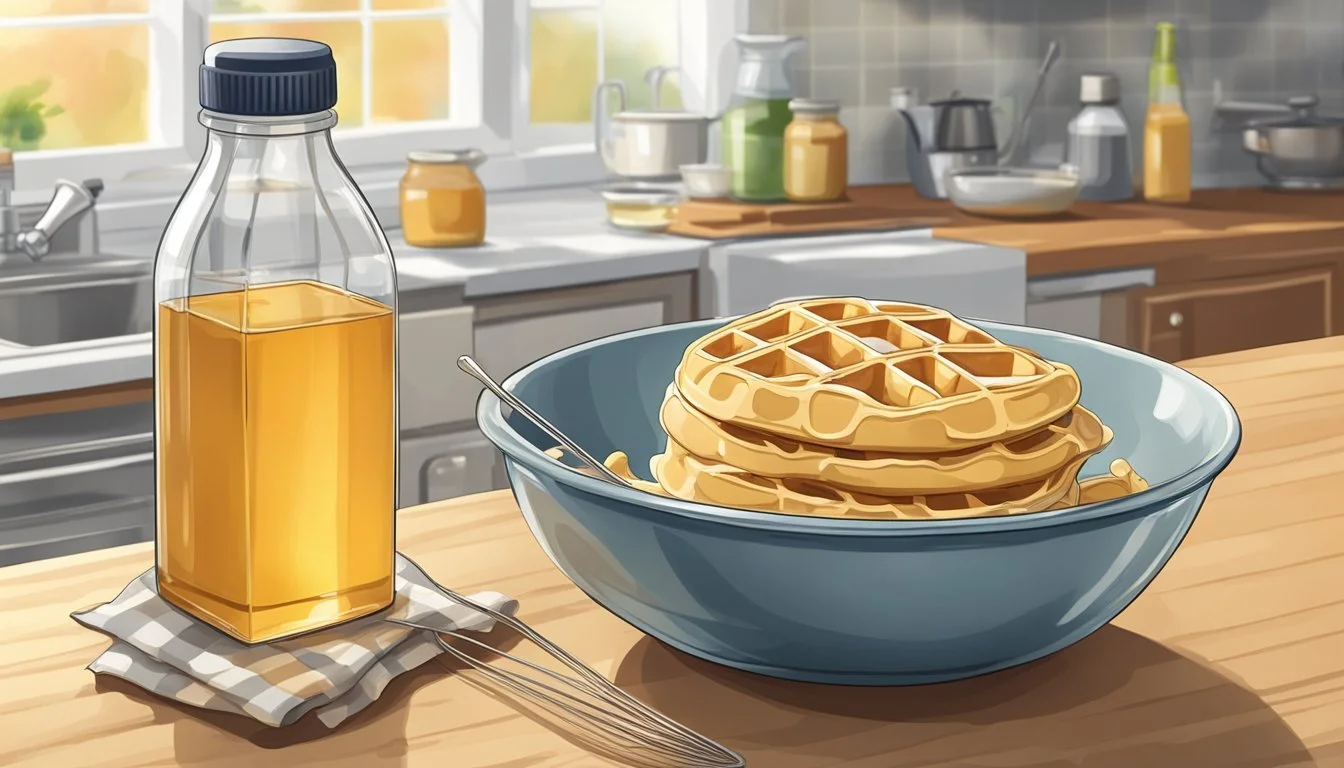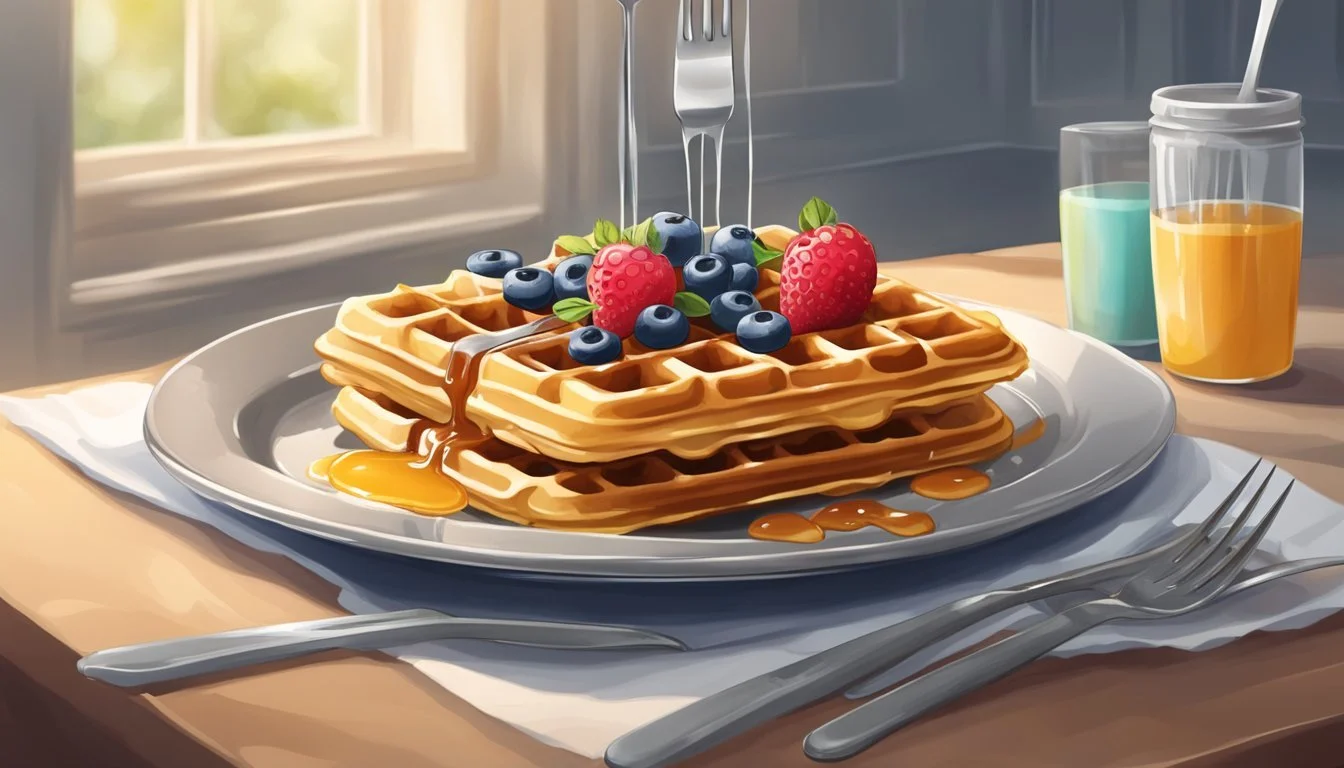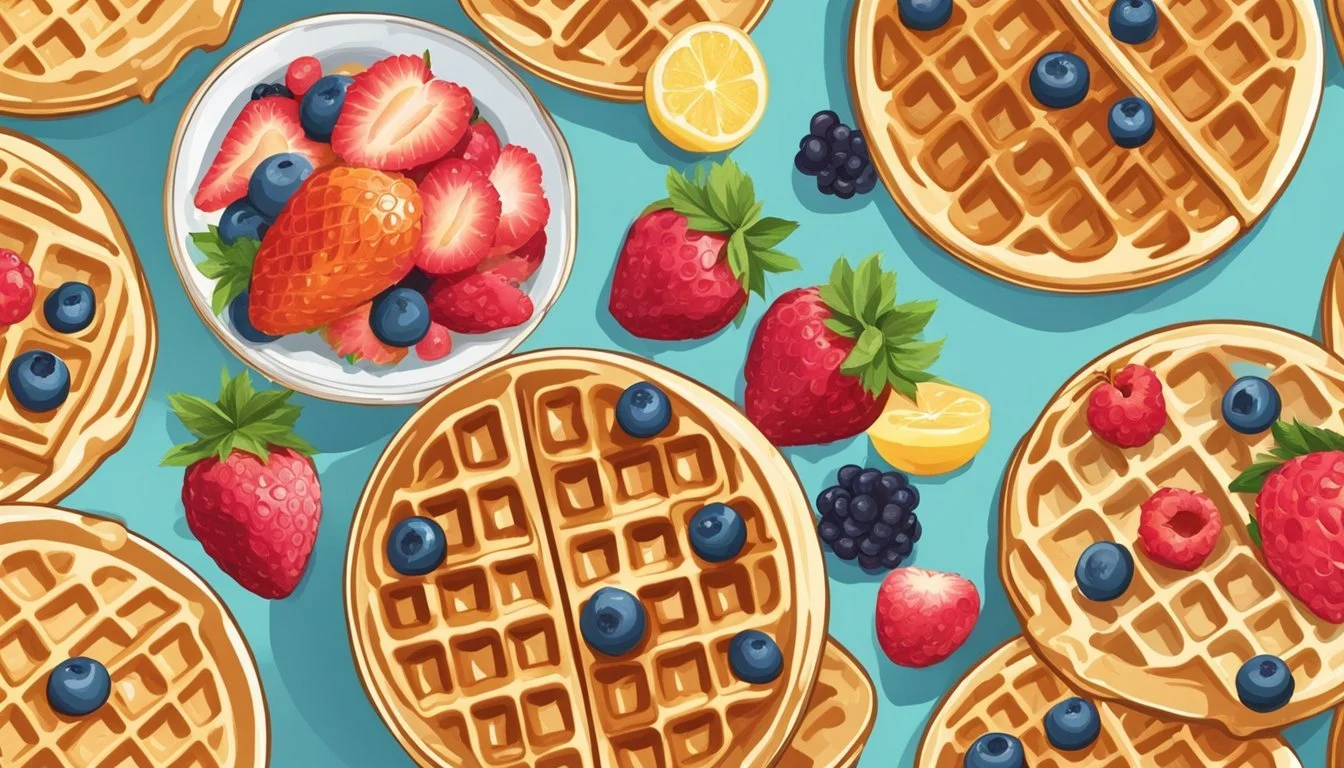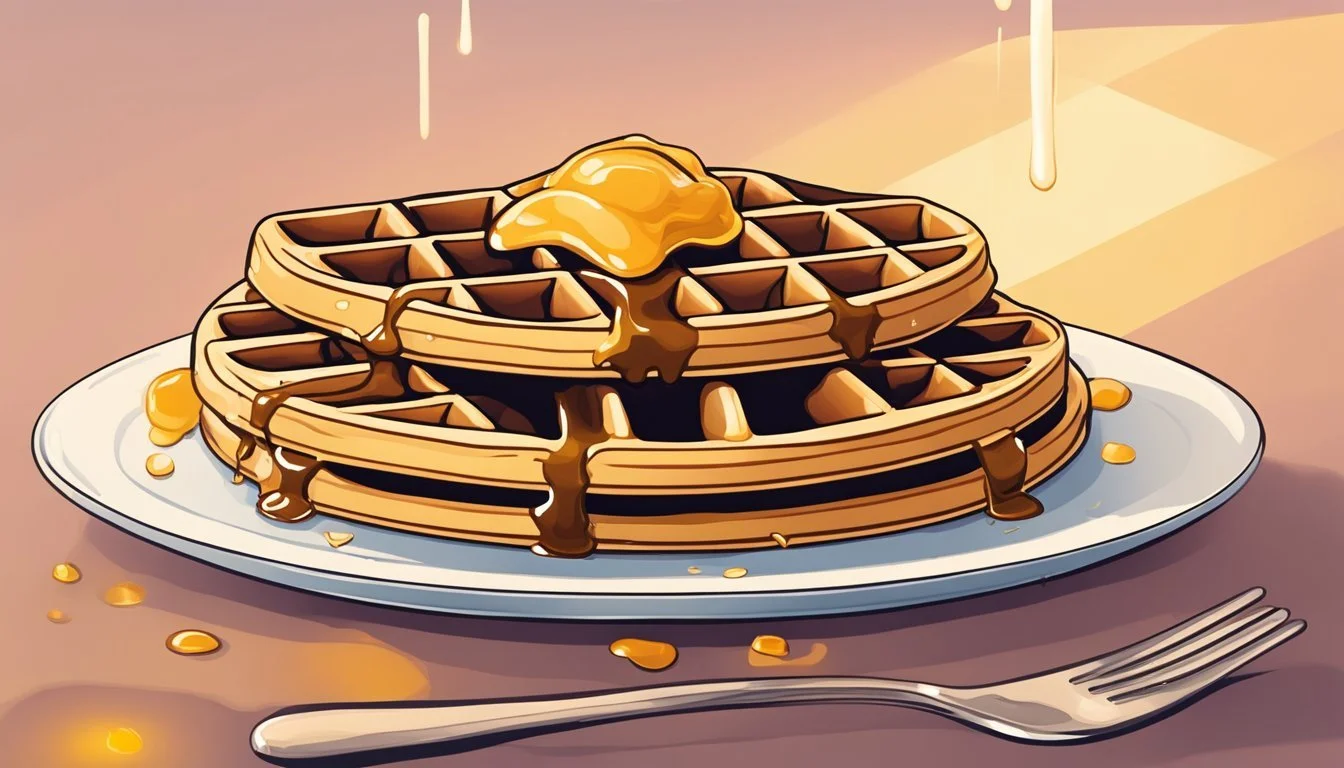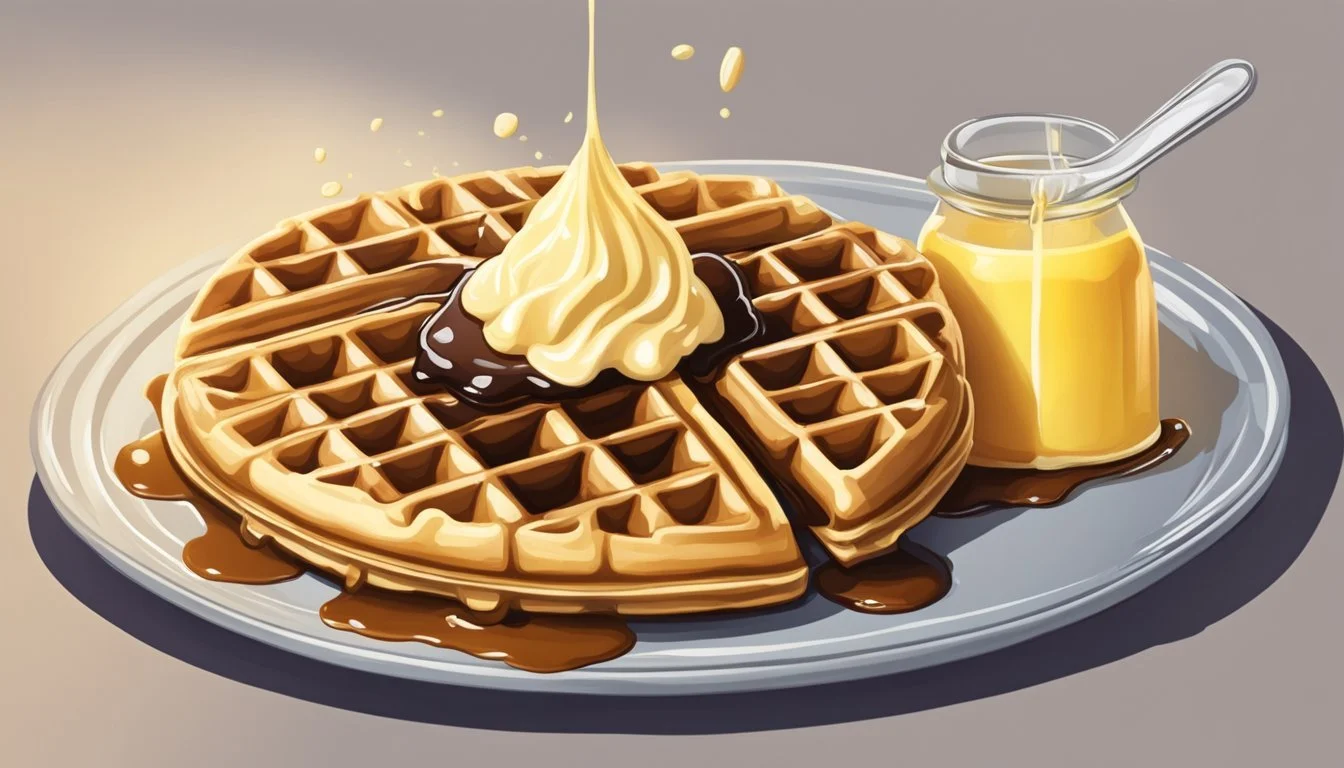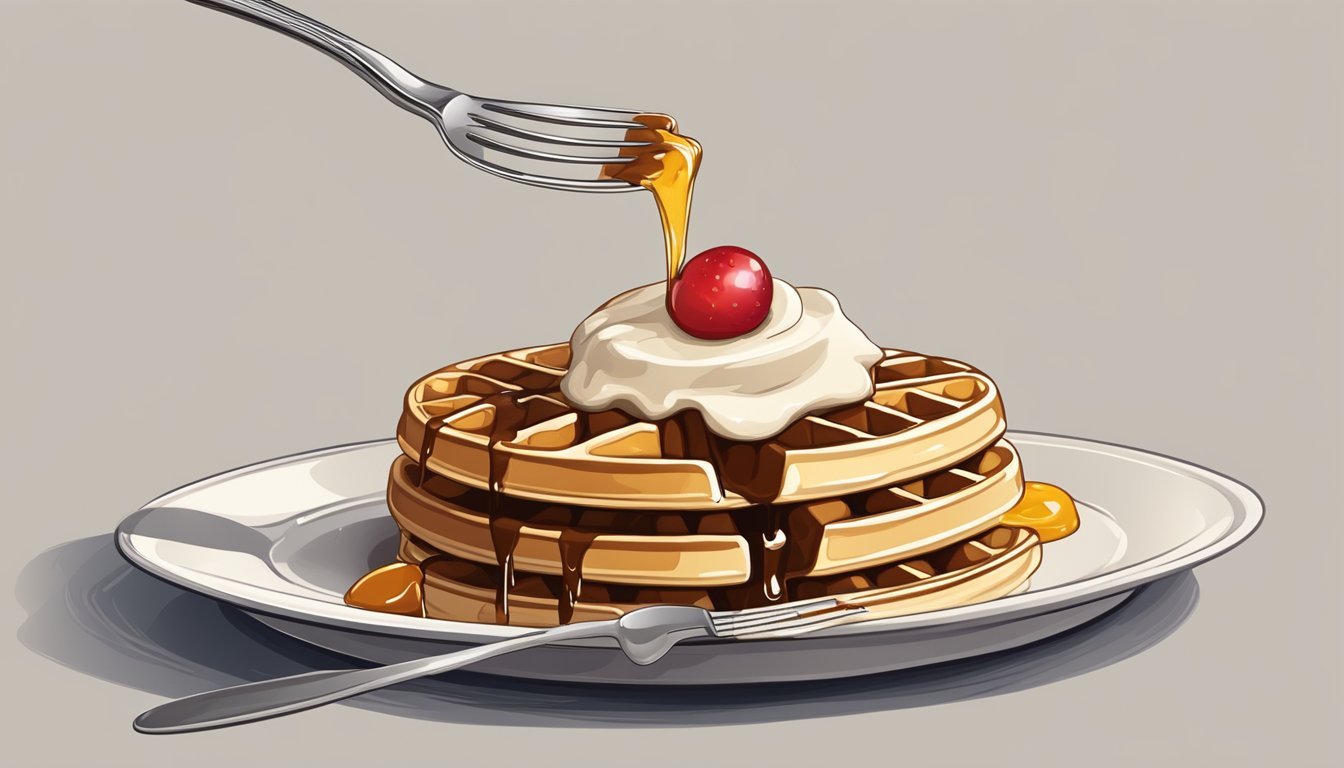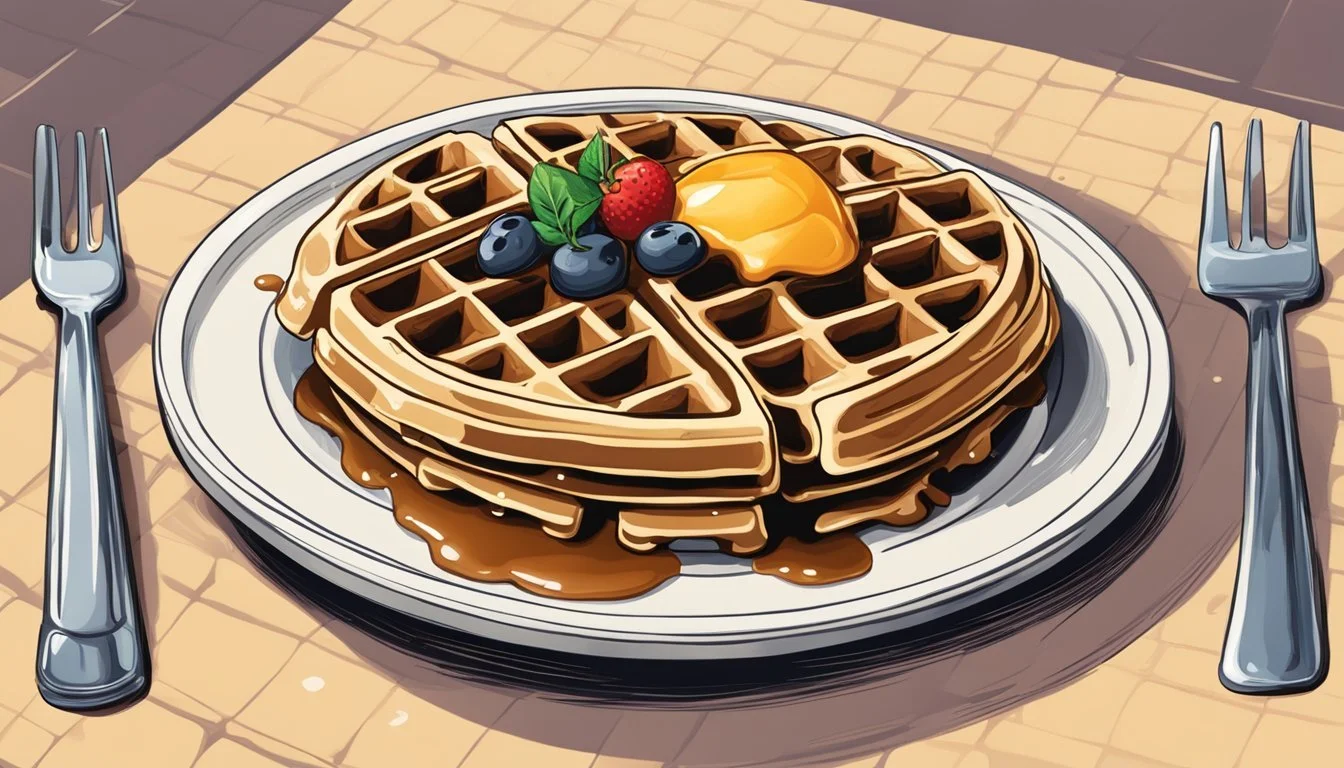How do you eat a waffle with syrup?
Mastering the Art of Perfect Waffle Enjoyment
Eating a waffle with syrup is a quintessential American breakfast experience that combines the soft, warm indentations of the waffle with the sweet, often maple-flavored, syrup. The process is straightforward: cook the waffle to the desired crispness, then proceed to cover it with the syrup. The grid-like pattern of waffles is perfect for holding the syrup, allowing each bite to be evenly infused with its flavor.
The versatility of waffles makes them a delightful option for any meal, not just breakfast. Syrup, while a traditional choice, is one among many other toppings that can enhance the taste of a waffle.
One must also consider the balance of flavors and textures when adding syrup to a waffle. It should complement the waffle's flavor without overpowering it, and the quantity should be just enough to seep into the pockets without making the waffle soggy. This balance ensures that each bite is a harmonious blend of the waffle's fluffiness and the syrup's richness.
Waffle Basics
When indulging in waffles, understanding their composition and the importance of a suitable waffle maker can greatly enhance the experience.
What Are Waffles?
Waffles are a delightful treat made from a leavened batter that includes ingredients such as flour, milk, eggs, and sugar. This mixture often contains baking powder or yeast as a rising agent to create the classic fluffiness. Waffles come in different varieties, with some recipes calling for buttermilk for a richer flavor and softer texture. They are cooked until golden brown with a characteristic grid pattern that gives them their unique look and crispy edges.
Choosing the Right Waffle Maker
A waffle maker or waffle iron is crucial to achieving perfect waffles. Waffle makers come in many forms, from traditional cast iron to modern electric appliances. When selecting a waffle maker, consider the following:
Type: Belgian waffle makers produce thick waffles with deep pockets, whereas standard waffle irons create thinner, crisper waffles.
Material: Non-stick surfaces ensure easy waffle release and cleanup.
Features: Look for adjustable temperature controls, indicator lights, and consistent heat distribution.
Each waffle maker varies in how it interacts with the batter, affecting the outcome of the waffles, from their texture to how well they hold toppings like syrup.
Preparing the Waffle Batter
Creating the perfect waffle batter involves careful blending of dry and wet ingredients to ensure a balance of flavor and texture. The batter should not be overmixed to maintain the waffles' light and fluffy quality.
Mixing Dry Ingredients
In a large mixing bowl, they combine the core dry ingredients. This includes:
2 cups of all-purpose flour
2 tablespoons of sugar
1 tablespoon of baking powder
1/2 teaspoon of salt
They whisk these ingredients together vigorously to remove any lumps, ensuring an even distribution.
Adding Wet Ingredients
Next, they introduce the wet ingredients into the mixture. Here is a standard list of wet ingredients:
2 eggs, beaten until light
1 3/4 cups of milk or buttermilk for added tanginess
1/2 cup of melted, unsalted butter or oil for richness
1 teaspoon of pure vanilla extract for flavor
They add the wet ingredients to the dry mix, stirring until just combined; the batter should still have a few lumps. Overmixing can result in dense waffles, so this step requires a gentle hand.
Cooking the Waffle
Cooking a waffle to perfection involves a series of detailed steps that ensure the final product is deliciously crispy and golden. The following instructions will guide the reader through preheating the waffle iron, properly using cooking spray, and pouring the batter into the iron.
Preheating the Waffle Iron
One begins making a waffle by first preheating the waffle iron. It's crucial to allow the iron to fully reach the desired temperature before adding the batter; this typically takes about 5 to 10 minutes, depending on the iron. A hot iron is the first step to achieving that desired crispy exterior.
Using Cooking Spray
Before pouring the batter, it is important to coat the waffle iron with cooking spray. This prevents the batter from sticking to the iron and helps in easy waffle release after cooking. For best results, one should apply a light, even coat, making sure to cover all the grids.
Pouring the Batter
Once the waffle iron is preheated and sprayed, it's time to pour the batter. One should use about 1/2 cup for standard waffle irons, pouring it into the center of the iron and spreading it evenly towards the edges. This quantity ensures the batter reaches the corners without overflowing, which is key for achieving an evenly cooked, crispy waffle.
Selecting the Syrup
Choosing the right syrup for waffles can elevate the dish from a mere breakfast item to a delightful culinary experience. Various types of syrup offer different flavor profiles, which can be matched according to personal preference and the waffle type.
Types of Syrup
There is a wide array of syrups to consider when topping waffles. The most popular choices include maple syrup, honey, and fruit-flavored syrups like blueberry or strawberry. Other inventive options such as caramel and chocolate syrup provide a dessert-like quality to the meal.
Maple Syrup: A classic choice with a rich, distinctive flavor
Honey: Adds a natural sweetness with a beautifully smooth consistency
Fruit Syrups: Like blueberry or strawberry syrup, bring a tart and sweet fruitiness
Chocolate Syrup: Offers a decadent, cocoa-infused taste
Caramel Syrup: Delivers a creamy, buttery, and rich flavor
Maple Syrup
Maple syrup is the traditional companion to waffles, treasured for its earthy, robust aroma and the depth of flavor it provides. It comes in various grades, each with its own color and taste intensity:
Grade A Golden Color: Delicate taste
Grade A Amber Color: Rich taste
Grade A Dark Color: Robust taste
The choice among these grades affects the waffle eating experience, with darker syrups complementing heartier waffle varieties.
Alternative Syrup Options
For individuals seeking alternatives to maple syrup, the market is brimming with a range of other syrups:
Buttermilk Syrup: A creamy, tangy twist on classic syrup
Honey: It's a natural sweetener with a lighter, more floral taste than syrups
Chocolate Syrup: Ideal for those craving a sweet, chocolaty touch
Caramel Syrup: Provides a touch of indulgent sweetness with a hint of vanilla
Fruit-Based Syrups: Such as blueberry and strawberry, offer brightness and a burst of fruit flavor
One may choose a single type or combine syrups to create a unique blend that caters to their taste buds.
Adding Toppings
When dressing a waffle with syrup, the addition of toppings can transform the experience. Toppings range from sweet to savory and can also provide a healthier option depending on one's dietary needs and preferences.
Sweet Toppings
Sweet toppings are a popular choice for enhancing the flavor of waffles. A simple yet classic option is to add a dollop of whipped cream, drizzle with chocolate syrup, and sprinkle on a handful of chocolate chips. For fruit lovers, fresh berries such as blueberries and strawberries offer a refreshing taste, while pecans or peanuts provide a satisfying crunch.
Fresh Fruit: Slices of strawberries, whole blueberries
Nuts: Crushed peanuts, chopped pecans
Cream: Dollops of whipped cream
Savory Toppings
Those with a penchant for savory foods might partake in waffle toppings like crisp bacon or a sprinkle of shredded cheese. For a more elaborate dish, one could top waffles with avocado slices or a perfectly poached egg, finished with a drizzle of hollandaise sauce.
Protein: Crumbled bacon, poached eggs
Creaminess: Sliced avocado, melted cheese
Healthy Toppings
For a more nutritious approach, waffles can be paired with health-conscious toppings. Greek yogurt provides a creamy texture with added protein, while almond butter offers a rich, nutty flavor and healthy fats. Those who prefer a tangier topping might opt for spreading cream cheese (how long does cream cheese last?) lightly.
Dairy Alternatives: A spoonful of Greek yogurt, a smear of cream cheese
Nut Spreads: Drizzle of almond butter
By selecting from these topping categories, one can dress a syrupy waffle to suit any palate, whether seeking indulgence or mindful eating.
Serving and Eating Waffles
When serving and eating waffles, the focus is on presentation, the right tools, and savoring the variety of flavors that can accompany this dish, whether it's for breakfast or brunch (What wine goes well with brunch?).
The Art of Plating
Plating waffles is both an aesthetic and practical approach to enhance the eating experience. A waffle is typically served on a flat plate with each quadrant readily accessible. Syrup is carefully poured over the top, saturating the waffle's distinctive grid pattern without overwhelming it. For a touch of elegance, a dollop of butter can be added to the center or top of the waffle, allowing it to melt into each pocket. Additional waffle toppings can include a dusting of powdered sugar, slices of fresh fruit, or a sprinkle of cinnamon for an extra layer of flavor.
Proper Utensils
The utensils needed to enjoy waffles should include a fork and knife. The fork is used to hold the waffle in place while the knife cuts through the soft texture. For kids, it is sometimes preferred to cut the waffle into smaller pieces beforehand to make it easier to handle. The fork's tines are perfect for picking up bite-sized pieces, especially when they are soaked with syrup and are too delicate to be handled with fingers.
Enjoying the Flavors
To truly relish waffles, one must appreciate the harmoniousness of its flavors and textures. With a foundation of a crispy, yet soft, waffle, the addition of syrup adds a sweet and sticky counterpart that is both decadent and comforting. Patrons can experiment with different types of syrup, like maple or fruit-flavored, to find their preferred taste. The combination of warm waffles and cool syrup often strikes a delightful contrast that many find appealing during breakfast or brunch time.
Creative Waffle Ideas
Exploring different waffle toppings and combinations can transform the humble waffle into a canvas for culinary creativity. These ideas span sweet and savory, and play with global influences.
Dessert Waffles
The Sundae Waffle: A scoop or two of ice cream, drizzled with chocolate sauce and caramel syrup, becomes a dessert delight when piled atop a freshly cooked waffle. Add whipped cream, a smattering of rainbow sprinkles, and a cherry to emulate the quintessential sundae experience.
Nutella and Fruit Waffle: A generous smear of Nutella pairs exquisitely with slices of banana or strawberries. For a zesty twist, dollop some lemon curd alongside for a tangy contrast.
Waffle Sandwiches
Peanut Butter and Jelly Waffle: For a playful take on a classic, spread peanut butter and your choice of jelly between two warm waffles. The heat gently melts them together, creating an irresistible sandwich.
Chicken and Waffle Sandwich: Channel the essence of Southern comfort by nesting crispy fried chicken between waffles drizzled with maple syrup or honey, merging savory and sweet.
Global Waffle Variations
Belgian Waffle Delight: Belgian waffles, known for their larger squares and lighter texture, are perfect with just a dusting of powdered sugar or loaded with fruit and whipped cream.
Pizza Waffle: For an Italian twist, top waffles with marinara sauce, mozzarella cheese, and your favorite pizza toppings. (What wine goes well with pizza toppings?) Cook until the cheese is melted and bubbly for a delightful fusion dish.
Making Waffles Healthier
When making waffles healthier, the focus is on ingredient substitution and thoughtful choices in toppings and add-ins. By selecting nutrient-dense options and reducing added sugars, one can enjoy waffles that are both tasty and better for overall health.
Substituting Ingredients
Whole Wheat Flour: Replace all-purpose flour with whole wheat flour to increase the fiber content and add nutrients.
Oats: Incorporate oats for a hearty texture and added health benefits.
Sweeteners: Opt for natural sweeteners like honey instead of refined sugars to lessen the glycemic impact.
Toppings and Add-Ins
Fruits: Top your waffles with fresh blueberries, strawberries, or bananas (how long do bananas last?) for natural sweetness and a boost of vitamins.
Nut Butters: Spread almond butter on waffles for a rich flavor and healthy fats.
Yogurt: Dollop Greek yogurt on waffles to add creaminess and protein without excess calories.
Troubleshooting Common Waffle Issues
When preparing waffles, one may encounter issues with texture and doneness. This section provides guidance to address undercooked or overcooked waffles and batter consistency problems.
Undercooked or Overcooked Waffles
Undercooked Waffles: An undercooked waffle can be doughy and limp. One should ensure their waffle iron is heated to the correct temperature before adding the batter. Using a cooking spray may improve the release of waffles from the iron and help achieve a consistent cook.
Correct Temperature: Preheat the waffle iron until the indicator light signals it's ready.
Cooking Time: Follow the manufacturer's recommended cooking time, usually when steam stops escaping from the iron.
Overcooked Waffles: To prevent waffles from becoming too crispy or burnt, one must watch the cooking time closely. Overcooked waffles lose their fluffy texture and become tough.
Visual Check: Look for a consistent golden-brown color as an indicator of doneness.
Crispiness: If a crispy waffle is desired, one should remove it just as it reaches the desired coloration to avoid overcooking.
Batter Consistency Problems
Thin Batter: A thin batter may result in waffles that are not fluffy. The key is to use the correct ratio of dry to wet ingredients.
Baking Powder: Ensure there's enough baking powder, usually about 1 to 2 teaspoons per cup of flour, to aid in leavening.
Adjust liquids: Reduce the amount of liquid or add more flour to achieve a thicker consistency.
Thick Batter: Conversely, a thick batter can make waffles too dense. Batter should be viscous but pourable.
Consistency Check: The batter should fall off the spoon in a thick ribbon.
Ingredient Ratios: If the batter is too thick, one can add a small amount of liquid, like milk or water, to reach the desired consistency.
By following these tips, one can ensure their waffles are cooked to perfection and the batter has the ideal consistency for a delightful breakfast experience.
Advanced Waffle-Making Techniques
Advanced techniques in waffle-making revolve around the introduction of complex flavors and textures. Gourmet home cooks often experiment with yeast-based recipes and innovative flavor profiles to elevate the traditional waffle experience.
Yeast-Based Waffles
Yeast-based waffles offer a depth of flavor and lightness in texture that are the hallmarks of a well-crafted waffle. When preparing the batter:
Yeast: Utilize active dry yeast, allowing the batter to rise and develop flavors, typically for an hour or until it has doubled in size.
Temperature: Ensure that the liquid ingredients are warm (around 110°F) to activate the yeast without killing it.
The recipe tends to include:
Flour
Melted butter
Warm milk
Eggs (yolks and whites separated)
A dash of sugar, salt, and possibly vanilla extract for a hint of sweetness.
Experimenting with Flavors
To turn basic waffles into a gourmet treat, one can experiment with different flavors:
Sweet Enhancements:
Vanilla infuses a warm and classic flavor.
Ground cinnamon adds a subtle spiceness, and can be mixed with caster sugar to create cinnamon sugar.
Brown sugar can be used as an alternative to white sugar for a deeper, caramel-like sweetness.
Savory Twists:
Herbs such as rosemary or thyme can be finely chopped and added to the batter.
Introducing cheese into the batter adds a savory note, balancing the waffle's sweetness, suitable for a more substantial meal.
When incorporating flavors, it is crucial to mix them thoroughly into the batter to ensure an even distribution.
Cleaning and Maintenance
Effective cleaning and maintenance are essential for the longevity of a waffle iron and to ensure hygienic storage. Proper care prevents syrup residue and batter from building up, thus avoiding potential issues with waffle quality and appliance performance.
Waffle Iron Care
After using a waffle maker, one should always unplug it and let it cool completely. Once cooled, it's important to clean off any leftover batter or syrup. A damp cloth can be used to wipe down the plates, ensuring no water seeps into the electrical components. For stubborn residues, a soft-bristled brush can dislodge crumbs without scratching the non-stick surface. Applying cooking spray before every use will not only aid in easy waffle release but also simplify the cleaning process post-cooking.
Unplug and cool the waffle iron after each use.
Gently wipe with a damp cloth; avoid soaking.
Use a soft brush for stuck-on food particles.
Apply a thin layer of cooking spray before cooking to prevent sticking.
Storage Solutions
Storing a waffle maker correctly is just as important as cleaning it. One must always store the waffle iron in a dry place where ventilation is adequate to prevent moisture build-up, which could lead to mold or rust. The appliance should be kept in an upright or flat position depending on the design and always away from other kitchen tools that could scratch or damage it.
Optimal Storage Techniques:
Store in a dry, well-ventilated space.
Keep either upright or flat, following the manufacturer's guidance.
Protect from contact with utensils that may scratch the surface.
By following these focused care and storage guidelines, users will ensure their waffle maker is both clean and well-maintained, ready for the next delicious batch of waffles.
Conclusion
In the art of perfecting breakfast and brunch favorites, waffles remain a quintessential dish. Serving them requires a balance of technique and personal preference, especially when incorporating syrup. The standard guideline suggests using 2-3 ounces or roughly 1⁄4 cup of syrup for a short stack or one large waffle, respectively. Patrons should pour syrup in a controlled fashion, starting at the center and creating a spiral, ensuring even distribution.
Topping Options:
Fruit: Sliced bananas, strawberries for freshness
Nuts: Chopped for added texture
Sweet Spreads: Hazelnut spread for richness
Cream: Whipped cream for decadence
It is crucial to offer a variety of toppings, catering to diverse tastes and diets. Options range from the classic richness of chocolate and hazelnut spreads to the lightness of fresh fruit. For those seeking a bit of crunch, a sprinkle of nuts can elevate the experience.
Those preparing waffles should consider ingredient temperature. Using room-temperature or slightly warmed butter can enhance the melting synergy between butter and syrup. Lastly, in situations where multiple waffles are prepared, maintaining their warmth in an oven is advisable, ensuring that they retain their texture and heat until served.
Waffles are more than a recipe; they present an opportunity for culinary creativity. Whether served at a high-end restaurant or lovingly prepared in a home kitchen, each waffle offers a canvas for an array of tastes and textures. They embody the very essence of a versatile dish, capable of starting a day with sweetness and satisfaction.

